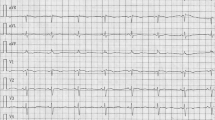Abstract
Congenital heart disease (CHD) is the most common predisposing factor for pediatric infective endocarditis (IE). Although patients with unrepaired ventricular septal defects (VSDs) are at greater risk of IE than those without CHD, the American Heart Association (AHA) considers VSDs to be relatively low risk and therefore does not recommend antibiotic prophylaxis against IE. Even among patients with VSDs who develop IE, current AHA and European Society for Cardiology (ESC) guidelines do not recommend surgical VSD closure, despite the potential for a second IE event. We present a case series of four children with small, restrictive, perimembranous VSDs who developed tricuspid valve (TV) IE. All four experienced delayed diagnosis and secondary complications, including three with septic pulmonary emboli. All four patients ultimately underwent surgical VSD closure. These cases highlight the importance of recognizing IE as a possible cause of prolonged fever in children, even among those with even ‘low-risk’ CHD. The cases also draw attention to the potential benefits of VSD closure in patients who develop IE.


Similar content being viewed by others
References
Baltimore RS, Gewitz M, Baddour LM et al (2015) Infective endocarditis in childhood: 2015 update: a scientific statement from the American Heart Association. Circulation 132(15):1487–1515. https://doi.org/10.1161/CIR.0000000000000298
Rushani D, Kaufman JS, Ionescu-Ittu R et al (2013) Infective endocarditis in children with congenital heart disease: cumulative incidence and predictors. Circulation 128(13):1412–1419. https://doi.org/10.1161/CIRCULATIONAHA.113.001827
Gersony WM, Hayes CJ, Driscoll DJ et al (1993) Bacterial endocarditis in patients with aortic stenosis, pulmonary stenosis, or ventricular septal defect. Circulation 87(2 Suppl):I121–I126
Wilson W, Taubert KA, Gewitz M et al (2007) Prevention of infective endocarditis: guidelines from the American Heart Association: a guideline from the American Heart Association Rheumatic Fever, Endocarditis, and Kawasaki Disease Committee, Council on Cardiovascular Disease in the Young, and the Council on Clinical Cardiology, Council on Cardiovascular Surgery and Anesthesia, and the Quality of Care and Outcomes Research Interdisciplinary Working Group. Circulation 116(15):1736–1754. https://doi.org/10.1161/CIRCULATIONAHA.106.183095
Steckelberg JM, Wilson WR (1993) Risk factors for infective endocarditis. Infect Dis Clin North Am 7(1):9–19
Frontera-Izquierdo P, Cabezuelo-Huerta G (1992) Natural and modified history of isolated ventricular septal defect: a 17-year study. Pediatr Cardiol 13(4):193–197. https://doi.org/10.1007/BF00838775
Soufflet V, Van de Bruaene A, Troost E et al (2010) Behavior of unrepaired perimembranous ventricular septal defect in young adults. Am J Cardiol 105(3):404–407. https://doi.org/10.1016/j.amjcard.2009.09.047
Berglund E, Johansson B, Dellborg M et al (2016) High incidence of infective endocarditis in adults with congenital ventricular septal defect. Heart 102(22):1835–1839. https://doi.org/10.1136/heartjnl-2015-309133
Gabriels C, De Backer J, Pasquet A et al (2017) Long-term outcome of patients with perimembranous ventricular septal defect: results from the belgian registry on adult congenital heart disease. Cardiology 136(3):147–155. https://doi.org/10.1159/000448513
Jortveit J, Leirgul E, Eskedal L et al (2016) Mortality and complications in 3495 children with isolated ventricular septal defects. Arch Dis Child 101(9):808–813. https://doi.org/10.1136/archdischild-2015-310154
Lee PT, Uy FM, Foo JS, Tan JL (2018) Increased incidence of infective endocarditis in patients with ventricular septal defect. Congenit Heart Dis 13(6):1005–1011. https://doi.org/10.1111/chd.12667
Vincent LL, Otto CM (2018) Infective endocarditis: update on epidemiology, outcomes, and management. Curr Cardiol Rep 20(10):86. https://doi.org/10.1007/s11886-018-1043-2
Baumgartner H, Bonhoeffer P, De Groot NM et al (2010) ESC Guidelines for the management of grown-up congenital heart disease (new version 2010). Eur Heart J 31(23):2915–2957. https://doi.org/10.1093/eurheartj/ehq249
Baumgartner H, De Backer J, Babu-Narayan SV et al (2021) 2020 ESC Guidelines for the management of adult congenital heart disease. Eur Heart J 42(6):563–645. https://doi.org/10.1093/eurheartj/ehaa554
Chahoud J, Sharif Yakan A, Saad H, Kanj SS (2016) Right-sided infective endocarditis and pulmonary infiltrates: an update. Cardiol Rev 24(5):230–237
Saxena A, Aggarwal N, Gupta P, Juneja R, Kothari SS, Math R (2011) Predictors of embolic events in pediatric infective endocarditis. Indian Heart J 63(3):237–240
Hussain ST, Witten J, Shrestha NK, Blackstone EH, Pettersson GB (2017) Tricuspid valve endocarditis. Ann Cardiothorac Surg 6(3):255–261. https://doi.org/10.21037/acs.2017.03.09
Nishimura RA, Otto CM, Bonow RO et al (2014) 2014 AHA/ACC Guideline for the management of patients with valvular heart disease: executive summary: a report of the American College of cardiology/American Heart Association task force on practice guidelines. Circulation 129(23):2440–2492 (Published correction appears in Circulation 129(23):e650)
Funding
No funding was provided for this case series.
Author information
Authors and Affiliations
Contributions
SH and AC: Conceptualized the case series and compiled the group of patients included. AB: Performed chart review to compile the patient vignettes and drafted and revised the initial manuscript and figures. AB and AC: Reviewed patient echocardiography to select high yield images for inclusion. DK: Performed the surgeries for all of the patients included in the case series, provided surgical expertise and perspective, provided the intraoperative photograph included in the submission. AH: Provided infectious disease expertise and perspective for the case summaries and discussion. All authors reviewed and approved the final manuscript and accompanying materials as submitted and agree to be accountable for all aspects of the work.
Corresponding author
Ethics declarations
Conflict of interest
All authors declare that they have no conflicts of interest to disclose.
Additional information
Publisher's Note
Springer Nature remains neutral with regard to jurisdictional claims in published maps and institutional affiliations.
Rights and permissions
About this article
Cite this article
Butensky, A.M., Channing, A., Handel, A.S. et al. Tricuspid Valve Endocarditis in Four Patients with Unrepaired Restrictive Perimembranous Ventricular Septal Defects. Pediatr Cardiol 43, 1929–1933 (2022). https://doi.org/10.1007/s00246-022-02938-5
Received:
Accepted:
Published:
Issue Date:
DOI: https://doi.org/10.1007/s00246-022-02938-5




